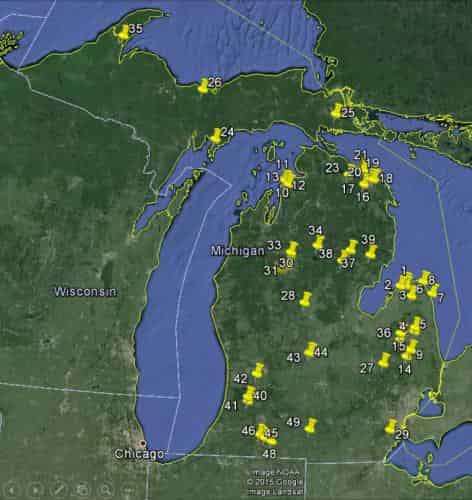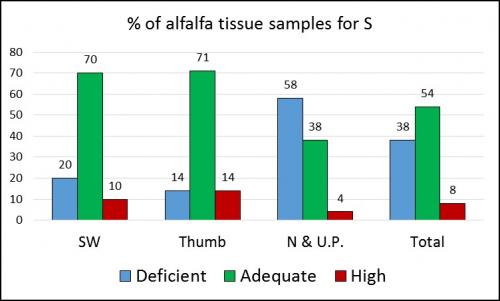- Mature stands of alfalfa (with no sulfur application).
- Sandy, coarse-textured soils where sulfur will readily leach.
- Low organic matter soils.
- High yielding environments (with no sulfur application).
- Non-manured fields.
MSU Extension initiated an alfalfa tissue test survey during summer 2015 to evaluate the level of nutrients found in producers’ alfalfa fields. The survey did not have enough samples to be statistically analyzed, but does provide an opportunity to observe trends and have a good snapshot of nutrient availability. Every region of the state (Figure 1) was represented, with a total of 52 samples from second, third and fourth cutting submitted for evaluation. The survey results identified a trend for alfalfa sulfur deficiency especially in fields like those described above.

Figure 1. Field locations using Google Earth show the locations for the alfalfa tissue samples.
Figure 2 shows the results of the survey where 38 percent of all samples tested were deficient. The highest region was the Upper Peninsula and northern Michigan where soil textures are normally more sandy in nature. The southwest region had the next highest percentage of deficient fields sampled and when you consider this area has areas of sandy, coarse-textured soils, producers should closely monitor fields where leaching may be more prevalent. The area of the state with the lowest percent of deficient samples occurred in the Thumb. This area has a high number of acres that receive manure and also have more clay textured soils that are less prone to S deficiencies.

Figure 2. Percent of Michigan samples by region showing levels of sulfur (S).
The survey trends, especially in Michigan’s southwest, Upper Peninsula and northern regions where more sandy soils are found, should be a source of concern for producers. If sulfur deficiency is suspected, tissue test confirmation followed by a good sulfur fertility program can solve the problem. Sulfate is the form of sulfur that is taken up by plants. Current recommendations are to add 25 pounds of sulfur per acre in a sulfate form to deficient fields. Elemental sulfur does not convert to sulfate quickly enough to be available for a sulfur-deficient crop. Annual applications of sulfur may be needed on fields with a history of sulfur deficiency.
If a field is found to have a sulfur deficiency, a treatment of a sulfate fertilizer can provide dramatic results quickly as shown in Photo 1. A sulfate application can provide an increase of up to 1 ton of dry matter per acre according to Carrie Laboski, University of Wisconsin-Madison soil fertility/nutrient management specialist. Her research has shown that the greater the deficiency, the greater the response will be to a sulfate fertilizer application.
The trend found in this survey shows the need for further research to be done in Michigan to help identify ways for more producers to achieve high yielding alfalfa production.
Source:msu.edu